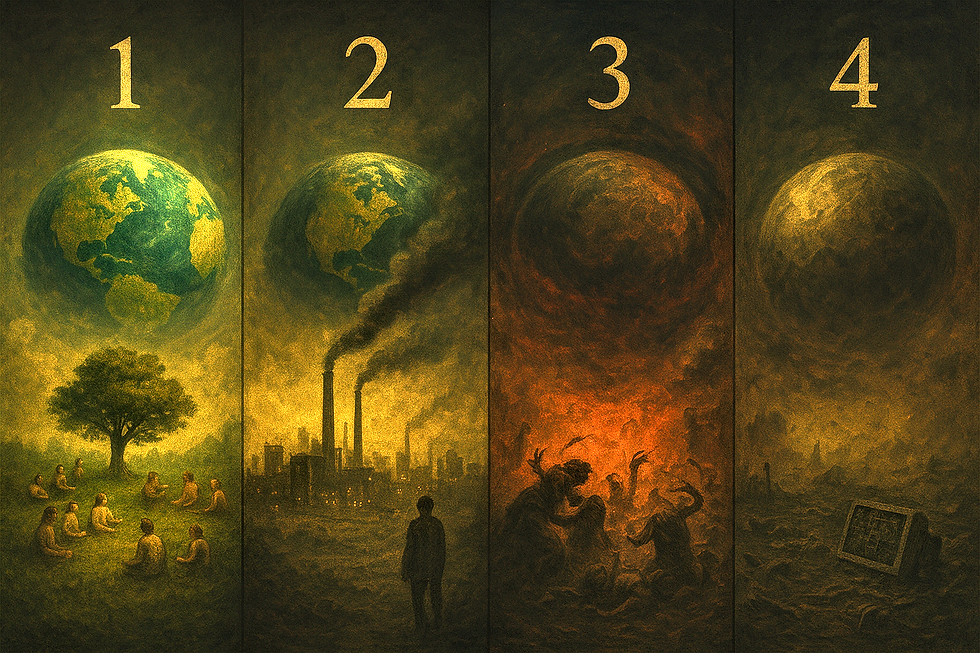Giving In vs Giving Up: Personal and Planetary Hospice
- adannoone

- Dec 19, 2024
- 2 min read

In the liminal spaces where endings converge—whether at a loved one’s bedside or confronting global ecological collapse—we encounter a profound spiritual and psychological challenge: how to remain present, purposeful, and loving when an end seems inevitable.
Acceptance is not a passive state, but an active, courageous engagement with reality. It requires us to simultaneously hold multiple emotional and intellectual truths: acknowledging profound loss while maintaining radical acceptance, recognizing systemic collapse while nurturing remaining life systems, feeling deep grief while creating meaning.
At both personal and planetary scales, hospice represents a threshold of transformation. In individual hospice, we witness a human being's intimate journey toward death—a process of profound vulnerability, release, and potential final connections. Similarly, planetary hospice invites us to witness global ecological transitions, where entire ecosystems, climate patterns, and ways of living are fundamentally changing and, yes, in so many ways, ending.
The critical distinction between acceptance and resignation lies in the quality of presence. Resignation disconnects, withdraws, and surrenders without care. Acceptance, conversely, remains radically engaged—it is love in action. It says: "I see what is happening. I will not turn away. I will remain present. Heartfully."
This requires extraordinary introspection and psychological resilience. In order to keep our own sanity, we must cultivate practices that allow us to metabolize grief, maintain compassionate awareness, and create meaning within limitation. Live mindfully. Keep connecting—building relationships with individuals, with nature, with animals. Find peace in ritual—feeding the birds, a morning walk, saying goodnight to the moon or to loved ones far removed by time or place. The simplest of rituals can help keep us feeling... human. Along with ritual, creative expression become crucial technologies of the human spirit.
If you’ve read any of my stuff, you know that I like to write fiction to calm myself. We all tell ourselves stories, right? Sometimes a story is a better explanation than an explanation. So, again, for those enjoy short stories, I present:
The Gardener's Vigil

Isa tended two gardens that summer—one in her backyard, the other within herself.
The first garden was literal: tomato vines, kale, lavender. The second garden was her mother's dying process. Her mother, Nadia, was in hospice, her body gradually releasing its hold on life.
Each morning, Isa would water her plants, noting how some were thriving while others were clearly dying. Some vegetables would not mature. Some flowers would not bloom. Yet she continued to tend everything with equal care, noticing the needs of everything she loved.
In the hospital, she practiced the same approach with her mother. Some conversations blossomed with unexpected intimacy. Others were sparse and quiet. She did not demand life where death was present, nor did she abandon hope where connection remained possible.
"I'm not giving up," Isa told her mother one afternoon. "I'm just being here with what is. I'm just being. With you."
Nadia squeezed her hand—a gesture of a lifetime of understanding.
Later, on her evening walk through her changing neighborhood marked by drought-stressed trees and resilient wildflowers, Isa realized her gardens—personal and planetary—were teaching the same lesson: Life persists, not through denial, but through conscious, loving presence. Even when death exists and insists, we still try to help however we can.
Acceptance, she understood, was not about outcome. It was a pragmatically loving relationship with truth.





Comments